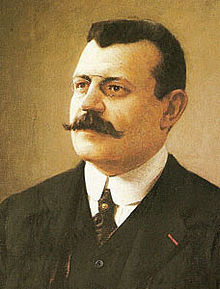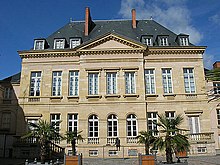Joseph Déchelette
Joseph Déchelette (born January 8, 1862 in Roanne , Loire ; † October 3, 1914 in Vingré , Aisne ) was a French archaeologist who researched in particular the precursors of ancient ceramics . He was among the first to establish a link between the La Tène culture and the Celts . His Manuel d'archéologie préhistorique, celtique et gallo-romaine was the first systematic manual of prehistoric and early historical archeology .
Life
Joseph Déchelette came from a wealthy industrial family in Roanne and attended the Marist school in Saint-Chamond . His uncle Jacques Gabriel Bulliot (1817-1902), who was an important member of the local antiquity society Société éduenne d'Autun in Autun , aroused his interest in archeology early on. Nevertheless, after completing school and military service in Saint-Étienne, he first entered the family business. He stayed there until 1899, although his archaeological interests increasingly prevailed.
In 1884 he joined the archaeological society La Diana , based in Montbrison ( Loire ), whose aim was to record and study the monuments of the province of Forez , south of Roanne . The Société française d'archéologie financed his work as an inspector. From 1892 Déchelette was an honorary curator of the Roanne Museum. In 1899 Joseph Déchelette finally gave up his work in his father's company to devote himself exclusively to prehistoric archeology. After he had freed himself from professional constraints, he was able to study the numerous excavations and museums of France and travel to the Orient, Belgium, Germany, Austria-Hungary, Italy, Spain and French North Africa , and finally with the writing of books begin, so that between 1908 and 1914 he was able to publish the first volumes of Manuel d'archéologie préhistorique, celtique et gallo-romaine . The work placed prehistoric archeology on a new foundation and is considered a foundation of modern and scientific archeology.
When the First World War broke out in 1914 , despite his advanced age, Déchelette was drafted into the 104th regiment of the French Army in an effort to close the gaps after the Battle of the Marne . As captain of the 298th Infantry Regiment, he died on October 3, 1914 at the front ( Mort pour la France ) . Today he rests in the Ambleny military cemetery and his name is registered in the Panthéon in Paris among the 560 writers who died in the First World War. The Imperial German Archaeological Institute commemorated him in 1914 alongside German archaeologists who had died in its Archaeological Gazette .
Archaeological work
From February to April 1893 Déchelette undertook a trip to Egypt , from which he returned with the mummy of Nesyamons, who probably died at the age of fifteen and who sang for the god Amun during his lifetime in Thebes .
Joseph Déchelette was the first to prove a cultural unity north of the Alps at the end of the Iron Age by comparing the results of the archaeological excavations of four Oppida : Bibracte in Burgundy , Manching in Bavaria , Stradonice in Bohemia and Velem-Szentvid in Hungary . He introduced the term "Oppida civilization", which is now regarded as the final period of the Celtic civilization on the European continent in a region that stretches from the south of England to Central Europe.
Déchelette also visited the Altamira cave in Spain, which he called the “ Sistine Chapel of Paleolithic Art” in 1908 . The term was later taken up again when Henri Breuil called the Lascaux Cave the "Sistine Chapel of Périgordien ", referring to the "deceased Joseph Déchelette".
Joseph Déchelette Museum
Déchelette had acquired the old palace of the Valence de Minardière family in Roanne in 1896 . There he lived and built up his extensive library. His widow left the house to the town of Roanne, but stayed on the ground floor until her death in 1957. In 1923 the municipal museum, founded in 1844 and directed by Déchelette since 1892, opened in his honor as the Musée de Beaux-Arts et d'Archéologie Joseph Déchelette . The museum also keeps the personal and scientific estate of Joseph Déchelette.
European Archeology Prize
At the suggestion of his great-nephew, Édouard Déchelette (†), the Association Joseph Déchelette was founded in 2010 with the aim of keeping the memory of this scientist and pioneer of archeology alive. In cooperation with various partners, the Association awards the European Archeology Prize Joseph Déchelette ( French Prix européen d'archéologie Joseph Déchelette ), which is intended to honor the doctoral thesis of a young archaeologist after completing his doctorate. The prize includes prize money as well as the opportunity to do research at various institutions.
The award is aimed at the broad community of archaeological researchers in Europe. The criteria for his award are based on the values that distinguished Joseph Déchelette: openness, scientific diligence, a sense of the practical and an international perspective. The work to be awarded must deal in a broader sense with the area of the recent prehistory of Europe, both geographically and chronologically (pre-Roman metal ages and the Romanization epoch). The award is made regardless of the language in which the doctoral thesis was written.
This prize, created in 2016, is to be awarded every two years by an international commission.
Partners for the award ceremony in 2018:
- Ministère de la culture et de la communication , Paris
- Joseph-Déchelette Museum, Roanne
- Musée d'Archéologie Nationale (MAN), Saint-Germain-en-Laye
- Roman-Germanic Central Museum (RGZM), Mainz
- Parc et Musée d'archéologie de Neuchâtel , Laténium
- Association pour les Recherches sur l'Âge du Bronze (APRAB)
- French Association for l'Etude de l'Âge du Fer (AFEAF)
- European Association of Archaeologists
- Fédération des Groupes de Recherche archéologique de la Loire (FRAL)
- Bibracte EPCC
Prize winners:
- 2016: Eneko Hiriart ( Université Bordeaux Montaigne , laboratoire Ausonius): Pratiques économiques et monétaires entre l'Èbre et la Charente (Ve – Ier saC).
- 2018: Sasja van der Vaart-Verschoof ( Universiteit Leiden ): Constructing Powerful Identities. The conception and meaning of 'rich' Hallstatt burials in the Low Countries (800–500 BC).
Publications (selection)
Déchelette's main work is the Manuel d'archéologie préhistorique, celtique et gallo-romaine , which he could only complete until the La Tène period . His plan to continue the work into the Gallo-Roman period could only be implemented by Albert Grenier .
- with Éleuthère Brabant: Les peintures murales du Moyen-age et de la Renaissance en Forez. Brassart, Montbrison 1900.
- Les vases céramiques ornés de la Gaule romaine (Narbonnaise, Aquitaine et Lyonnaise). Two volumes. Picard, Paris 1904 ( digitized volume 1 ; digitized volume 2 ).
-
Manuel d'archéologie préhistorique, celtique et gallo-romaine . Four volumes. Picard, Paris 1908-1914.
- Volume 1: Archeology préhistorique . 1908 ( digitized version ).
- Volume 2: Archéologie celtique, ou protohistorique .
- Volume 2, 1: You bronze . 1910 ( digitized ).
- Volume 2, 2: Premier âge du Fer ou époque de Hallstatt . 1913.
- Volumes 2, 3: Deuxième âge du Fer ou époque de La Tène . 1914.
See the list of publications: Joseph Déchelette, les publications européennes (hors Forez, Roannais et Lyonnais) ( French ) Ewiranda. Retrieved May 26, 2019.
literature
- Émile Chatelain : Éloge funèbre de M. Joseph Déchelette, correspondant français de l'Académie. In: Comptes rendus des séances de l'Académie des Inscriptions et Belles-Lettres. 1914, pp. 574-577 ( digitized version ).
- Salomon Reinach : Joseph Déchelette . In: Revue archéologique . tape 24 , 1914, pp. 315-327 ( bnf.fr ).
- Ernest Albert Parkyn: Joseph Déchelette . In: Man. Royal Anthropological Institute of Great Britain and Ireland . tape 15 , 1915, pp. 122-124 , JSTOR : 2787872 .
- François Déchelette (Ed.): Livre d'or de Joseph Déchelette, centenaire 1862–1962 . Sully, Roanne 1962.
- Marie-Suzanne Binétruy: De l'art roman à la préhistoire, des sociétés locales à l'institut. Itinéraires de Joseph Déchelette . LUGD, Lyon 1994, ISBN 2-84147-008-3 .
Web links
- Serge Lewuillon: Déchelette, Joseph. In: Dictionnaire critique des historiens de l'art actifs en France de la Révolution à la Première Guerre mondiale .
- Bibliotheque numerique de Roanne: Joseph Déchelette Fund , estate.
Remarks
- ↑ S. Reinach, p. 327. Quotation from the Journal officiel de la République française : "Déchelette, capitaine de territoriale au 298 e régiment d'infantrie, a été tué le 3 octobre, [..]"
- ^ Lothar Wickert : Contributions to the history of the German Archaeological Institute 1879 to 1929. Verlag Philipp von Zabern, Mainz 1979, ISBN 3-8053-0395-5 , p. 169.
- ↑ S. Reinach, p. 315.
- ↑ a b c Joseph Déchelette. Les Amis du Musée et de la Médiathèque de Roanne, accessed November 16, 2014 .
- ↑ a b S. Reinach, p. 316.
- ↑ Les 560. (PDF) Retrieved November 16, 2014 .
- ↑ Archäologischer Anzeiger 1914, Col. 497–498: "In the ranks of our opponents fell ..."; Lothar Wickert: Contributions to the history of the German Archaeological Institute 1879 to 1929. Verlag Philipp von Zabern, Mainz 1979, ISBN 3-8053-0395-5 , p. 24.
- ↑ In the original: "Chapelle Sixtine de l'art quaternaire", where "quaternaire" literally corresponds to the Quaternary , but in the context of that time this must be understood as a reference to the Paleolithic. Quote from: Manuel d'archéologie prehistorique celtique et gallo-romaine . tape 1 . Picard, Paris 1908, p. 150 ( archive.org ).
- ^ Henri Breuil: Découverte d'une remarquable grotte ornée, au domaine de Lascaux, Montignac (Dordogne) . In: Comptes-rendus des séances de l'Académie des Inscriptions et Belles-Lettres . 1940, p. 390 ( persee.fr ).
- ^ Prix européen d'archéologie Joseph Déchelette 2018. UMR8546 CNRS / ENS-Paris AOROC Archeologie et Philologie d'Orient et d'Occident, April 20, 2018, accessed on July 10, 2018 .
- ↑ Albert Grenier: Manuel d'archéologie gallo-romaine (= Manuel d'archéologie préhistorique celtique et gallo-romaine. Volumes 5–8). Picard, Paris 1931-1960.
| personal data | |
|---|---|
| SURNAME | Déchelette, Joseph |
| BRIEF DESCRIPTION | French archaeologist |
| DATE OF BIRTH | January 8, 1862 |
| PLACE OF BIRTH | Roanne , Loire |
| DATE OF DEATH | October 3, 1914 |
| Place of death | Vingré , Aisne |

